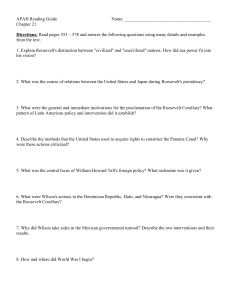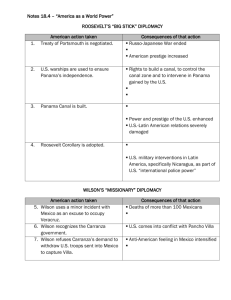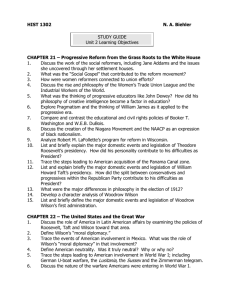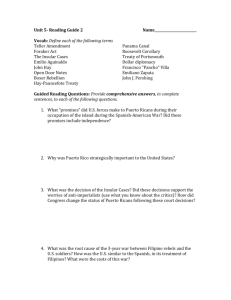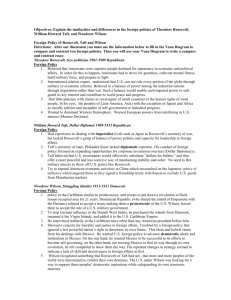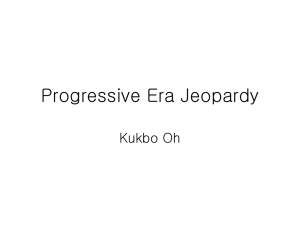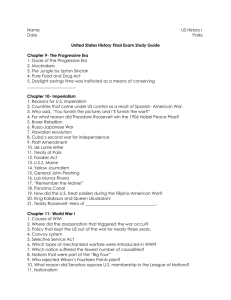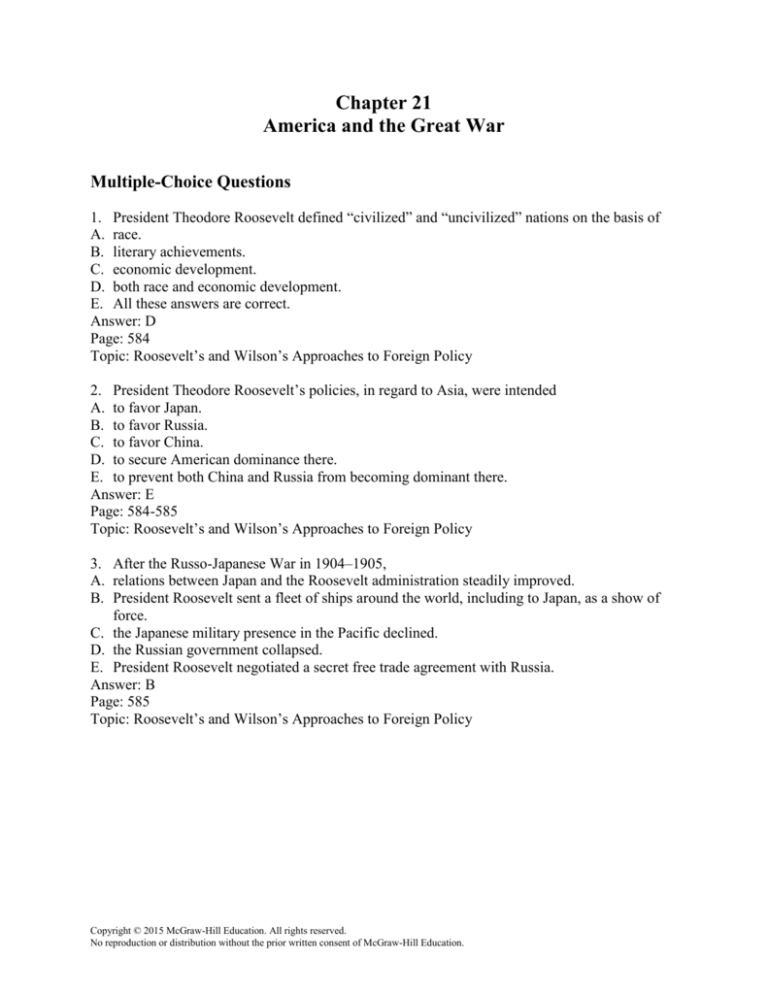
Chapter 21
America and the Great War
Multiple-Choice Questions
1. President Theodore Roosevelt defined “civilized” and “uncivilized” nations on the basis of
A. race.
B. literary achievements.
C. economic development.
D. both race and economic development.
E. All these answers are correct.
Answer: D
Page: 584
Topic: Roosevelt’s and Wilson’s Approaches to Foreign Policy
2. President Theodore Roosevelt’s policies, in regard to Asia, were intended
A. to favor Japan.
B. to favor Russia.
C. to favor China.
D. to secure American dominance there.
E. to prevent both China and Russia from becoming dominant there.
Answer: E
Page: 584-585
Topic: Roosevelt’s and Wilson’s Approaches to Foreign Policy
3. After the Russo-Japanese War in 1904–1905,
A. relations between Japan and the Roosevelt administration steadily improved.
B. President Roosevelt sent a fleet of ships around the world, including to Japan, as a show of
force.
C. the Japanese military presence in the Pacific declined.
D. the Russian government collapsed.
E. President Roosevelt negotiated a secret free trade agreement with Russia.
Answer: B
Page: 585
Topic: Roosevelt’s and Wilson’s Approaches to Foreign Policy
Copyright © 2015 McGraw-Hill Education. All rights reserved.
No reproduction or distribution without the prior written consent of McGraw-Hill Education.
4.
A.
B.
C.
D.
As part of his Asian diplomacy, President Theodore Roosevelt
signed a secret agreement with Japan to ensure continued American trade in Asia.
sent a fleet of battleships to Japan as a show of American military power.
extracted from Russia a recognition of Japan’s territorial gains in the Russo-Japanese War.
both signed a secret agreement with Japan to ensure continued American trade in Asia, and
sent a fleet of battleships to Japan as a show of American military power.
E. All these answers are correct.
Answer: E
Page: 585
Topic: Roosevelt’s and Wilson’s Approaches to Foreign Policy
5. The 1904 “Roosevelt Corollary”
A. was invalidated by the Supreme Court during the Wilson administration.
B. stated that neighboring countries had to adhere to U.S. policy in times of war.
C. was created as a result of a military crisis in Cuba.
D. stated that the U.S. had a right to intervene in the affairs of neighboring countries.
E. stated that England and England alone was exempted from the Monroe Doctrine.
Answer: D
Page: 585-586
Topic: Roosevelt’s and Wilson’s Approaches to Foreign Policy
6. Prior to the United States’ construction of the Panama Canal,
A. the French had tried but failed to build a canal at the same site.
B. the United States had failed to build a canal across Nicaragua.
C. the British had failed to build a canal across Costa Rica.
D. the Germans had failed to build a canal at the same site.
E. no country had attempted to build a canal connecting the Atlantic with the Pacific.
Answer: A
Page: 586
Topic: Roosevelt’s and Wilson’s Approaches to Foreign Policy
7. In order to secure control of the Panama Canal zone, the United States
A. carried out the overthrow of the president of Panama.
B. organized a trade embargo against Colombia.
C. assisted a revolution in Panama.
D. purchased the land for the canal from Colombia.
E. surrounded the canal site with a “Great White Fleet.”
Answer: C
Page: 587
Topic: Roosevelt’s and Wilson’s Approaches to Foreign Policy
Copyright © 2015 McGraw-Hill Education. All rights reserved.
No reproduction or distribution without the prior written consent of McGraw-Hill Education.
8. “Dollar Diplomacy” is associated primarily with the administration of
A. William McKinley.
B. William Howard Taft.
C. Theodore Roosevelt.
D. Woodrow Wilson.
E. Warren Harding.
Answer: B
Page: 587
Topic: Roosevelt’s and Wilson’s Approaches to Foreign Policy
9. The policy idea behind “Dollar Diplomacy” was to
A. create stable governments in less-developed nations.
B. reduce the deployment of troops from the United States to other nations.
C. encourage other nations to peg their currency to the U.S. dollar.
D. financially reward Latin nations that supported the interests of the United States.
E. extend investments and influence of the United States in less-developed regions.
Answer: E
Page: 587
Topic: Roosevelt’s and Wilson’s Approaches to Foreign Policy
10. The diplomatic efforts of President Woodrow Wilson toward Latin America
A. were decidedly non-expansionist.
B. curtailed the use of the military as a tool of diplomacy.
C. became known as the “good neighbor” policy.
D. were similar to those of Theodore Roosevelt and William Howard Taft.
E. were the product of considerable interest and experience in international affairs.
Answer: D
Page: 587
Topic: Roosevelt’s and Wilson’s Approaches to Foreign Policy
11. In the early twentieth century, the United States’ actions toward Mexico included
A. encouraging an overthrow of the Madero government.
B. a refusal to formally recognize the Huerta government.
C. sending an American expeditionary force across the border into Mexico.
D. both encouraging an overthrow of the Madero government and refusing to formally
recognize the Huerta government.
E. All these answers are correct.
Answer: E
Page: 588
Topic: Roosevelt’s and Wilson’s Approaches to Foreign Policy
Copyright © 2015 McGraw-Hill Education. All rights reserved.
No reproduction or distribution without the prior written consent of McGraw-Hill Education.
12. In his dealings with Pancho Villa, President Woodrow Wilson
A. ordered a military expedition into Mexico to capture Villa.
B. saw American troops capture Villa and bring him to the United States.
C. eventually released Villa in order to smooth relations with the Carranza government.
D. both ordered a military expedition into Mexico to capture Villa, and eventually released Villa
in order to smooth relations with the Carranza government.
E. All these answers are correct.
Answer: A
Page: 589
Topic: Roosevelt’s and Wilson’s Approaches to Foreign Policy
13. In 1914, the “Triple Entente” consisted of
A. Italy, France, and Russia.
B. Great Britain, France, and the United States.
C. Germany, the Austro-Hungarian Empire, and Italy.
D. Great Britain, France, and Russia.
E. Germany, Italy, and Japan.
Answer: D
Page: 589
Topic: The Road to World War I
14. On the eve of the Great War, the chief rivalry in Europe was between
A. Germany and Great Britain.
B. Austro-Hungary and Russia.
C. Germany and France.
D. France and Russia.
E. France and Great Britain.
Answer: A
Page: 589
Topic: The Road to World War I
15. The immediate spark for hostilities in Europe in 1914 was
A. a struggle between European powers for control of the international diamond trade.
B. the sinking of the British passenger liner Lusitania.
C. the death of Otto von Bismarck in Germany.
D. the German invasion of Poland.
E. the assassination of the Archduke Franz Ferdinand.
Answer: E
Page: 589
Topic: The Road to World War I
Copyright © 2015 McGraw-Hill Education. All rights reserved.
No reproduction or distribution without the prior written consent of McGraw-Hill Education.
16. In 1914, when war erupted in Europe, President Woodrow Wilson
A. called on the American public to be completely impartial.
B. expressed sympathy for Germany.
C. declared that the “Triple Alliance” must be defeated.
D. held secret diplomatic meetings with Great Britain.
E. brokered separate peace treaties with both sides of the conflict.
Answer: A
Page: 589
Topic: The Road to World War I
17. In 1914–1915, the United States responded to a British naval blockade of Germany by
A. ending trade with all of Europe to maintain its neutrality.
B. ending trade with Great Britain to pressure it to lift the blockade.
C. defying the blockade and continuing to trade with Germany.
D. ending trade with Germany but continuing trade with Great Britain.
E. rerouting all trade with Germany through the Mediterranean.
Answer: D
Page: 589-590
Topic: The Road to World War I
18. In the aftermath of the sinking of the British passenger liner Lusitania,
A. the United States declared war on Germany.
B. Germany pledged to the United States it would not repeat such an action.
C. President Wilson prohibited Americans from traveling to Europe.
D. Great Britain began an intensive campaign to build a submarine fleet.
E. the United States began leasing its submarines to Great Britain.
Answer: B
Page: 590
Topic: The Road to World War I
19. In the fall of 1915, President Woodrow Wilson
A. stated that the United States was likely to enter the war within a year.
B. ordered American troops to staging camps in England.
C. began to support a rapid increase of the nation’s armed forces.
D. was firmly rooted within the peace faction of the Democratic Party.
E. sent Secretary of State William Jennings Bryan to broker a peace settlement.
Answer: C
Page: 590
Topic: The Road to World War I
Copyright © 2015 McGraw-Hill Education. All rights reserved.
No reproduction or distribution without the prior written consent of McGraw-Hill Education.
20. In the election of 1916, supporters of Woodrow Wilson
A. helped the president easily beat his Republican opponent.
B. called his Republican opponent a pacifist who would not act to save England.
C. felt betrayed when the president stated that the nation’s entrance into the war was inevitable.
D. were anxious for the president to declare war before election day.
E. hinted that his Republican opponent would lead the nation into war.
Answer: E
Page: 590
Topic: The Road to World War I
21. In January 1917, President Woodrow Wilson, in a speech before Congress,
A. suggested the creation of the League of Nations in the postwar period.
B. insisted that the nation’s financial interests had to be protected from a German victory.
C. asked for a declaration of war against Germany.
D. said Britain and France could not win the war without the United States.
E. argued that entering the war would be a tragic mistake under any circumstances.
Answer: A
Page: 591
Topic: The Road to World War I
22. The so-called “Zimmermann telegram”
A. was intercepted by agents working for the United States.
B. included a proposal for the return of the American Southwest to Mexico.
C. helped weaken public support in the United States for war.
D. revealed plans by Germany to expand the use of its submarine fleet.
E. revealed that Germans were attempting to foment a race riot in the American South.
Answer: B
Page: 591
Topic: The Road to World War I
23. In March 1917, the United States moved closer to entering the Great War when
A. the czarist government of Russia was overthrown.
B. the Bolsheviks came to power in Russia.
C. Russia asked the Allies to call for an armistice.
D. a German offensive threatened to capture Moscow.
E. Russia and Germany negotiated a separate peace.
Answer: A
Page: 591
Topic: The Road to World War I
Copyright © 2015 McGraw-Hill Education. All rights reserved.
No reproduction or distribution without the prior written consent of McGraw-Hill Education.
24. President Woodrow Wilson’s request to Congress for a declaration of war
A. was passed without a dissenting vote.
B. was nearly voted down in the Senate.
C. came before Germany took any military action against the United States.
D. took place two weeks after German submarines had torpedoed three Americans ships.
E. was supported by Republicans but opposed by most in Wilson’s own party.
Answer: D
Page: 591
Topic: The Great War
25. As the United States entered World War I, its most immediate military effect was in
A. western Europe.
B. the Far East.
C. north Africa.
D. eastern Europe.
E. the Atlantic Ocean.
Answer: E
Page: 591-592
Topic: The Great War
26. As the United States entered World War I,
A. President Woodrow Wilson declared U.S. ground troops would not be used.
B. Britain and France had few reserves of combat-age men.
C. Russia decided to re-enter the war.
D. Germany made plans to surrender.
E. Germany was threatening an invasion of Great Britain.
Answer: B
Page: 592
Topic: The Great War
27. The Selective Service Act in the United States
A. was enacted during the last months of World War I.
B. gave the government, for the first time, the authority to draft citizens for military duty.
C. was supported by President Woodrow Wilson.
D. drafted far fewer men than those who volunteered for military duty.
E. brought nearly 300,000 men into the army.
Answer: C
Page: 593
Topic: The Great War
Copyright © 2015 McGraw-Hill Education. All rights reserved.
No reproduction or distribution without the prior written consent of McGraw-Hill Education.
28. During World War I, American ground troops
A. saw combat that was relatively brief but intense.
B. were assigned to serve under the command of foreign officers.
C. were not available for battle in significant numbers until the fall of 1918.
D. both saw combat that was relatively brief but intense, and were assigned to serve under the
command of foreign officers.
E. None of these answers is correct.
Answer: A
Page: 593
Topic: The Great War
29. In World War I, the American Expeditionary Force was commanded by
A. George Marshall.
B. Arthur MacArthur.
C. George Patton.
D. John Pershing.
E. Leonard Wood.
Answer: D
Page: 593-594
Topic: The Great War
30. During World War I, the United States military effort in Europe
A. saw American soldiers engage solely in light skirmishes.
B. saw U.S. forces carry the fighting into Germany.
C. lasted only a few months but suffered light casualties compared to the other combatants.
D. saw American combat troops kept separate from Allied forces.
E. took place mostly in Belgium and the Netherlands.
Answer: C
Page: 594, 596
Topic: The Great War
31. During World War I, extensive systems of trenches were used by both sides
A. because the destructive power of weapons made conventional field battles too destructive.
B. because trenches prevented tanks from reaching the soldiers’ positions.
C. because soldiers were safer from poisonous mustard gas closer to the ground.
D. both because the destructive power of weapons meant soldiers could not live in the open
field, and because trenches prevented tanks from reaching the soldiers’ positions.
E. None of these answers is correct.
Answer: A
Page: 594
Topic: The Great War
Copyright © 2015 McGraw-Hill Education. All rights reserved.
No reproduction or distribution without the prior written consent of McGraw-Hill Education.
32. During World War I, the new technology of warfare
A. created logistical supply problems, which slowed many offensives.
B. allowed the attack of the enemy without direct combat.
C. were largely responsible for the appalling level of casualties.
D. both created logistical problems, which slowed many offensives, and allowed the attack of
the enemy without direct combat.
E. All these answers are correct.
Answer: E
Page: 594-595
Topic: The Great War
33. During World War I, airplanes were used for all of the following EXCEPT
A. bombing the enemy.
B. transporting troops.
C. attacking other aircraft.
D. reconnaissance.
E. “dogfights.”
Answer: B
Page: 595
Topic: The Great War
34. During World War I, technologically-advanced submarines used engines powered by
A. diesel.
B. gasoline.
C. steam.
D. electricity.
E. coal.
Answer: A
Page: 595
Topic: The Great War
35. The country that lost the greatest number of lives in World War I was
A. Russia.
B. Great Britain.
C. France.
D. Germany.
E. Italy.
Answer: D
Page: 595
Topic: The Great War
Copyright © 2015 McGraw-Hill Education. All rights reserved.
No reproduction or distribution without the prior written consent of McGraw-Hill Education.
36. American casualties in World War I
A. numbered approximately 350,000.
B. numbered approximately 60,000.
C. were as likely to be from disease as from combat.
D. were very low in all battles that U.S. troops participated in.
E. were comparable in number to those of the European powers.
Answer: C
Page: 596
Topic: The Great War
37. During World War I, the United States government primarily financed the war through
A. deficit spending and currency manipulation.
B. foreign loans and the printing of new currency.
C. private business and banking loans.
D. currency inflation and the sale of gold reserves.
E. public bond sales and new taxes.
Answer: E
Page: 596
Topic: The Great War and American Society
38. During World War I, the Council of National Defense eventually organized the national
economy by creating
A. state militias.
B. local defense councils.
C. nonprofit donation organizations.
D. congressional district war tax zones.
E. volunteer donation centers.
Answer: B
Page: 596
Topic: The Great War and American Society
39. During World War I, the War Industries Board (WIB)
A. was seen as a model for rational organization when led by Herbert Hoover.
B. was plagued by mismanagement and inefficiencies under Bernard Baruch.
C. coordinated government purchases of military supplies.
D. saw itself as an adversary of individual businesses.
E. All these answers are correct.
Answer: C
Page: 596
Topic: The Great War and American Society
Copyright © 2015 McGraw-Hill Education. All rights reserved.
No reproduction or distribution without the prior written consent of McGraw-Hill Education.
40. Which of the following did the National War Labor Board, established in 1918, NOT grant to
American workers?
A. an eight-hour work day
B. equal pay to women for equal work
C. collective bargaining rights
D. maintenance of minimal living standards
E. recognition of the right to strike
Answer: E
Page: 596-597
Topic: The Great War and American Society
41. In the United States during World War I, the Committee on Public Information (CPI)
A. established strict rules of censorship for journalists reporting on the war.
B. became increasingly sensationalist in its information campaign.
C. criticized the federal government’s reporting of the war.
D. was led by a panel of American military officers.
E. became a haven for pacifists and conscientious objectors.
Answer: B
Page: 602
Topic: Opposition to War and Government Reaction
42. The Sabotage Act and the Sedition Act of 1918
A. eliminated jury trials for anyone charged under these laws.
B. were most frequently directed at German Americans.
C. were created after the Supreme Court invalidated the Espionage Act of 1917.
D. made illegal any public expression opposing the war.
E. were rarely if ever enforced by the Wilson administration.
Answer: D
Page: 602
Topic: Opposition to War and Government Reaction
43. After the United States entered World War I,
A. most German Americans supported the American war effort.
B. German books were removed from many American schools and libraries.
C. the playing of German music was banned in many American communities.
D. sauerkraut in the U.S. was renamed “liberty cabbage.”
E. All these answers are correct.
Answer: E
Page: 602-603
Topic: Opposition to War and Government Reaction
Copyright © 2015 McGraw-Hill Education. All rights reserved.
No reproduction or distribution without the prior written consent of McGraw-Hill Education.
44. President Woodrow Wilson’s “Fourteen Points” included
A. a ban on the production of armaments.
B. an end to secret treaties.
C. an international agreement to “outlaw war.”
D. the division of postwar Germany into two countries.
E. recognition of independence for all imperial colonies.
Answer: B
Page: 603
Topic: The Search for a New World Order
45. In 1918, President Wilson’s “Fourteen Points” received significant political support from
A. the British government.
B. the United States Senate.
C. the French government.
D. both the British and French governments.
E. None of these answers is correct.
Answer: E
Page: 603
Topic: The Search for a New World Order
46. In 1918, President Woodrow Wilson antagonized many Republicans
A. when he pushed for the election of Democrats to Congress.
B. when he refused to put prominent Republicans on the peace conference negotiating team.
C. when he tied support of his peace plans to the midterm elections.
D. both when he tied support of his peace plans to the midterm elections and when he pushed
for the election of Democrats to Congress.
E. All these answers are correct.
Answer: E
Page: 603
Topic: The Search for a New World Order
47. In 1919, all of the following figures were at the Paris Peace Conference EXCEPT
A. Alexander Kerensky of Russia.
B. Georges Clemenceau of France.
C. David Lloyd George of Great Britain.
D. Vittorio Orlando of Italy.
E. Woodrow Wilson of the United States.
Answer: A
Page: 604
Topic: The Search for a New World Order
Copyright © 2015 McGraw-Hill Education. All rights reserved.
No reproduction or distribution without the prior written consent of McGraw-Hill Education.
48. In 1919, President Woodrow Wilson believed the Paris Peace Conference treaty
A. should have placed large reparations on the defeated Central Powers.
B. agreed with most of his Fourteen Points.
C. had ended colonialism.
D. was a success because of the acceptance of the League of Nations.
E. was a complete and utter failure.
Answer: D
Page: 605
Topic: The Search for a New World Order
49. During the last eighteen months of Woodrow Wilson’s presidency
A. his mental health was stable but his physical health was very poor.
B. he was essentially an invalid.
C. there was growing public sentiment for Wilson to step down from power.
D. his vice president, Thomas Marshall, essentially ran the White House.
E. he became more pragmatic and willing to compromise.
Answer: B
Page: 606
Topic: The Search for a New World Order
50. When President Woodrow Wilson presented the Treaty of Versailles to the Senate,
A. the American public clearly supported its ratification.
B. most so-called “irreconcilable” senators favored it in principle.
C. he was willing to compromise on the language of the treaty but not its major points.
D. he found a close ally in the Senate Foreign Relations Committee chairman, Henry Cabot
Lodge.
E. he refused to appeal to the public, believing the treaty should stand on its merits alone.
Answer: A
Page: 605
Topic: The Search for a New World Order
51. Regarding the Treaty of Versailles, the United States Senate decided in 1919 to
A. ratify it without change.
B. ratify it after Democrats accepted the Republican “reservations.”
C. ratify it with the change that the United States would not join the League of Nations.
D. ratify it only after Article X was struck from the treaty.
E. not ratify it.
Answer: E
Page: 606
Topic: The Search for a New World Order
Copyright © 2015 McGraw-Hill Education. All rights reserved.
No reproduction or distribution without the prior written consent of McGraw-Hill Education.
52. Immediately following World War I, the American economy
A. saw prices plunge.
B. fell into a protracted recession.
C. was marked by a continuing labor shortage.
D. boomed for many months.
E. fell into a deflationary spiral.
Answer: D
Page: 606
Topic: Repression and Reaction in the Postwar U.S.
53. In 1919, American labor unrest saw
A. the public generally support unions.
B. a general strike in Seattle that brought the city to a standstill.
C. a major steel strike resolved in favor of the workers.
D. Governor Calvin Coolidge attract national acclaim for his support of labor.
E. All these answers are correct.
Answer: B
Page: 607
Topic: Repression and Reaction in the Postwar U.S.
54. As a result of the service of African American soldiers in World War I,
A. activism by blacks for their rights increased.
B. public attitudes on race were significantly altered.
C. the country saw a general improvement in race relations.
D. the federal government integrated the armed forces.
E. northern black factory workers were able to keep their jobs when white veterans returned.
Answer: A
Page: 608
Topic: Repression and Reaction in the Postwar U.S.
55. In 1919, the racial climate in the United States
A. worsened in both the North and South.
B. worsened in the South but not in the North.
C. improved in both the North and South.
D. improved in the North but not in the South.
E. generally stayed the same as it had been before the war.
Answer: A
Page: 608
Topic: Repression and Reaction in the Postwar U.S.
Copyright © 2015 McGraw-Hill Education. All rights reserved.
No reproduction or distribution without the prior written consent of McGraw-Hill Education.
56. The most prominent exponent of black nationalism following World War I was
A. Claude McKay.
B. Booker T. Washington.
C. Marcus Garvey.
D. W. E. B. Du Bois.
E. Malcolm X.
Answer: C
Page: 609
Topic: Repression and Reaction in the Postwar U.S.
57. Marcus Garvey
A. encouraged African Americans to reject assimilation into white society.
B. argued that America, not Africa, was now the blacks’ true home.
C. urged African Americans to move out of the South.
D. called on African Americans to reject capitalism.
E. saw his movement and influence decline in the early 1920s.
Answer: A
Page: 609
Topic: Repression and Reaction in the Postwar U.S.
58. In 1919, the Red Scare in the United States
A. led to government raids that uncovered large caches of weapons.
B. saw more than 6,000 people deported from the country.
C. saw the arrest of several major government figures.
D. was generally opposed by universities and other academic institutions.
E. was partly motivated by a series of bombings.
Answer: E
Page: 609
Topic: Repression and Reaction in the Postwar U.S.
59. During the Red Scare of 1919, Attorney General A. Mitchell Palmer
A. oversaw the deportation of 6,000 people.
B. founded the Federal Bureau of Investigation.
C. argued for moderation and a cooling-off period.
D. argued for moderation and a cooling-off period, but at the same time oversaw the deportation
of 6,000 people.
E. None of these answers is correct.
Answer: E
Page: 610
Topic: Repression and Reaction in the Postwar U.S.
Copyright © 2015 McGraw-Hill Education. All rights reserved.
No reproduction or distribution without the prior written consent of McGraw-Hill Education.
60. In 1920, Nicola Sacco and Bartolomeo Vanzetti
A. admitted they were anarchists.
B. were convicted of murder.
C. drew widespread support from the public.
D. both admitted they were anarchists and drew widespread support from the public.
E. All these answers are correct.
Answer: E
Page: 610
Topic: Repression and Reaction in the Postwar U.S.
61. In 1920, passage of the Nineteenth Amendment
A. marked the beginning of a new era in progressive reform.
B. outlawed the production, sale, and consumption of alcohol.
C. gave women the right to vote.
D. required the direct election of senators.
E. disallowed Woodrow Wilson from running for a third term.
Answer: C
Page: 611
Topic: Repression and Reaction in the Postwar U.S.
62. The election of 1920 saw
A. voters turn away from idealism and toward “normalcy.”
B. Warren G. Harding narrowly defeat Al Smith.
C. the Democratic Party distance itself from the politics of Woodrow Wilson.
D. Republicans maintain their two decades of control of the White House.
E. Franklin D. Roosevelt serve as vice president on the Republican ticket.
Answer: A
Page: 611
Topic: Repression and Reaction in the Postwar U.S.
True/False Questions
63. President Roosevelt did not believe that Japan could be considered among the ranks of the
“civilized” countries.
Answer: False
Page: 584
Topic: Roosevelt’s and Wilson’s Approaches to Foreign Policy
64. President Taft’s “Dollar Diplomacy” brought stability to Latin America.
Answer: False
Page: 587-588
Topic: Roosevelt’s and Wilson’s Approaches to Foreign Policy
Copyright © 2015 McGraw-Hill Education. All rights reserved.
No reproduction or distribution without the prior written consent of McGraw-Hill Education.
65. In his diplomacy, President Wilson approached Latin America in a way that was very similar
to the approach of presidents Roosevelt and Taft.
Answer: True
Page: 587-588
Topic: Roosevelt’s and Wilson’s Approaches to Foreign Policy
66. In his dealings with Mexico, President Wilson often ignored Mexican sovereignty.
Answer: True
Page: 588
Topic: Roosevelt’s and Wilson’s Approaches to Foreign Policy
67. In early 1915, virtually the entire European continent was at war after the assassination of an
Austrian archduke provided the spark to hostilities on the continent.
Answer: True
Page: 589
Topic: The Road to World War I
68. The American response to the war in Europe was to accept the British blockade of Germany
and continue trading with Great Britain.
Answer: True
Page: 589
Topic: The Road to World War I
69. The German submarine attack on the British liner the Lusitania resulted in the death of more
than 100 Americans.
Answer: True
Page: 590
Topic: The Road to World War I
70. Between 1914 and 1916, the United States gradually transformed itself from a neutral
country into an arsenal of the Allies.
Answer: True
Page: 590
Topic: The Road to World War I
71. President Wilson refused to endorse American military rearmament until he was reelected in
1916.
Answer: False
Page: 590
Topic: The Road to World War I
Copyright © 2015 McGraw-Hill Education. All rights reserved.
No reproduction or distribution without the prior written consent of McGraw-Hill Education.
72. The Zimmermann telegram proposed an alliance between Mexico and Germany against the
United States.
Answer: True
Page: 591
Topic: The Road to World War I
73. When the United States entered World War I, Germany was near defeat.
Answer: False
Page: 591
Topic: The Great War
74. The entrance of the American military into World War I had its most immediate impact on
the naval war in the Atlantic Ocean.
Answer: True
Page: 591-592
Topic: The Great War
75. The majority of American soldiers who fought in World War I were volunteers.
Answer: False
Page: 592-593
Topic: The Great War
76. The most “modern” applications of new technology during World War I were in sea warfare.
Answer: True
Page: 595
Topic: The Great War
77. Britain lost more men in World War I then either France or the Austro-Hungarian Empire.
Answer: False
Page: 595
Topic: The Great War
78. The United States financed World War I solely through public bond sales.
Answer: False
Page: 596
Topic: The Great War and American Society
79. The War Industries Board, which coordinated government purchases of military supplies,
was headed by Herbert Hoover.
Answer: False
Page: 596
Topic: The Great War and American Society
Copyright © 2015 McGraw-Hill Education. All rights reserved.
No reproduction or distribution without the prior written consent of McGraw-Hill Education.
80. Most industrial laborers were required to work longer hours during World War I.
Answer: False
Page: 596
Topic: The Great War and American Society
81. One of the most important social changes of the war years was the migration of hundreds of
thousands of African Americans from the rural South to California to work in defense plants
and shipyards. This became known as the “Great Migration.”
Answer: False
Page: 598
Topic: The Great War and American Society
82. By 1917 the American decision to go to war was almost universally supported throughout the
country.
Answer: False
Page: 599
Topic: Opposition to War and Government Reaction
83. The Sedition Act made criticism of the war effort a crime.
Answer: True
Page: 602
Topic: Opposition to War and Government Reaction
84. In 1918, more than 1,500 people were arrested for criticizing the government.
Answer: True
Page: 602
Topic: Opposition to War and Government Reaction
85. President Wilson’s “Fourteen Points” did not at first include a call for a League of Nations.
Answer: False
Page: 603
Topic: The Search for a New World Order
86. The wild acclaim given by the European public to President Wilson allowed him to dominate
the terms of the Paris Peace Conference.
Answer: False
Page: 603
Topic: The Search for a New World Order
87. Republicans scored major victories in both houses of Congress in the elections of 1918.
Answer: True
Page: 603
Topic: The Search for a New World Order
Copyright © 2015 McGraw-Hill Education. All rights reserved.
No reproduction or distribution without the prior written consent of McGraw-Hill Education.
88. The new Bolshevik government of Russia was not a participant in the Paris Peace
Conference.
Answer: True
Page: 604
Topic: The Search for a New World Order
89. President Wilson was unable to win British and French support for his ideas of free trade and
freedom of the seas.
Answer: True
Page: 604
Topic: The Search for a New World Order
90. During the ratification debate on the Treaty of Versailles, it was clear the Republicans would
not compromise with President Wilson.
Answer: False
Page: 605-606
Topic: The Search for a New World Order
91. President Wilson refused to consider any Republican amendments or reservations to the
Treaty of Versailles.
Answer: True
Page: 605
Topic: The Search for a New World Order
92. The participation of blacks in the American army in World War I led to widespread calls for
integration of the military.
Answer: False
Page: 608
Topic: Repression and Reaction in the Postwar U.S.
93. The race riots of 1919 did not just involve white people attacking black people; they also saw
blacks retaliate against these attacks.
Answer: True
Page: 608
Topic: Repression and Reaction in the Postwar U.S.
94. Marcus Garvey called for blacks to reject capitalism.
Answer: False
Page: 609
Topic: Repression and Reaction in the Postwar U.S.
95. The Red Scare was primarily the result of anti-radical actions by various state governments.
Answer: False
Page: 609
Topic: Repression and Reaction in the Postwar U.S.
Copyright © 2015 McGraw-Hill Education. All rights reserved.
No reproduction or distribution without the prior written consent of McGraw-Hill Education.
96. The Sacco and Vanzetti case is in part a story of the lingering effects of the Red Scare on
post-World War I American society.
Answer: True
Page: 610-611
Topic: Repression and Reaction in the Postwar U.S.
97. Passage of the Nineteenth Amendment, granting women the right to vote, marked the
beginning of a new era of progressive reform.
Answer: False
Page: 611
Topic: Repression and Reaction in the Postwar U.S.
Fill-in-the-Blank Questions
98. The decision to send the “Great White Fleet” around the world was directed primarily at the
country of ________.
Answer: Japan
Page: 585
Topic: Roosevelt’s and Wilson’s Approaches to Foreign Policy
99. The “Roosevelt Corollary” to the ________ gave the United States greater power in Latin
America.
Answer: Monroe Doctrine
Page: 585-586
Topic: Roosevelt’s and Wilson’s Approaches to Foreign Policy
100. The most celebrated foreign policy accomplishment of Theodore Roosevelt’s presidency
was the construction of the ________.
Answer: Panama Canal
Page: 586
Topic: Roosevelt’s and Wilson’s Approaches to Foreign Policy
101. At first, President Roosevelt favored a canal route across ________.
Answer: Nicaragua
Page: 586
Topic: Roosevelt’s and Wilson’s Approaches to Foreign Policy
102. President Taft’s foreign policy was called “________ Diplomacy” by its critics.
Answer: Dollar
Page: 587
Topic: Roosevelt’s and Wilson’s Approaches to Foreign Policy
Copyright © 2015 McGraw-Hill Education. All rights reserved.
No reproduction or distribution without the prior written consent of McGraw-Hill Education.
103. President Wilson refused to recognize the government of Victoriano ________, though
American business interests supported the regime.
Answer: Huerta
Page: 588
Topic: Roosevelt’s and Wilson’s Approaches to Foreign Policy
104. President Wilson ordered General ________ to lead an American expeditionary force
across Mexico in pursuit of Pancho Villa.
Answer: John J. Pershing
Page: 589
Topic: Roosevelt’s and Wilson’s Approaches to Foreign Policy
105. World War I involved many nations, but the chief rivalry was between ________ and
Germany.
Answer: Great Britain
Page: 589
Topic: The Road to World War I
106. The assassination of ________ triggered World War I in Europe.
Answer: Archduke Franz Ferdinand
Page: 589
Topic: The Road to World War I
107. The May 1915 German attack on the ________ led to the death of over 1,200 passengers.
Answer: Lusitania
Page: 590
Topic: The Road to World War I
108. In 1916, Wilson’s reelection campaign slogan regarding World War I was “He ________.”
Answer: kept us out of war
Page: 590
Topic: The Road to World War I
109. In January 1917, President Wilson gave an important speech in which he called for a
permanent league of nations and a “peace without ________.”
Answer: victory
Page: 591
Topic: The Road to World War I
110. The American Expeditionary Force was commanded by General ________.
Answer: John J. Pershing
Page: 593-594
Topic: The Great War
Copyright © 2015 McGraw-Hill Education. All rights reserved.
No reproduction or distribution without the prior written consent of McGraw-Hill Education.
111. Soldiers on both sides carried gas masks at all times in case of a chemical attack of
poisonous ________.
Answer: mustard gas
Page: 594
Topic: The Great War
112. During World War I, the United States suffered ________ casualties.
Answer: 112,000
Page: 596
Topic: The Great War
113. During World War I, Denver journalist George Creel led the Committee on ________.
Answer: Public Information
Page: 602
Topic: Opposition to War and Government Reaction
114. The Espionage Act primarily targeted anti-capitalist groups, such as the Socialist Party and
the ________.
Answer: Industrial Workers of the World
Page: 602
Topic: Opposition to War and Government Reaction
115. President Harding pardoned ________, the leader of the Socialist Party that had been
imprisoned under new legislation like the Sedition Act.
Answer: Eugene V. Debs
Page: 602
Topic: Opposition to War and Government Reaction
116. The “Big Four” at Versailles included David Lloyd George, the prime minister of England,
and ________, the president of France.
Answer: Georges Clemenceau
Page: 604
Topic: The Search for a New World Order
117. Those senators who opposed the Treaty of Versailles on principle—many of whom were
western isolationists—were called ________.
Answer: irreconcilables
Page: 605
Topic: The Search for a New World Order
118. President Wilson’s major enemy in the fight over the League of Nations was ________.
Answer: Henry Cabot Lodge
Page: 605
Topic: The Search for a New World Order
Copyright © 2015 McGraw-Hill Education. All rights reserved.
No reproduction or distribution without the prior written consent of McGraw-Hill Education.
119. President Wilson believed that the presidential election of 1920 would serve as a “solemn
referendum” on the ________.
Answer: League of Nations
Page: 606
Topic: The Search for a New World Order
120. The greatest strike of 1919 took place in the ________ industry.
Answer: steel
Page: 607
Topic: Repression and Reaction in the Postwar U.S.
121. The United Negro Improvement Association was led by ________.
Answer: Marcus Garvey
Page: 609
Topic: Repression and Reaction in the Postwar U.S.
122. Attorney General ________’s heavy-handed response to the Red Scare of 1919 ultimately
ruined his career.
Answer: A. Mitchell Palmer
Page: 610-611
Topic: Repression and Reaction in the Postwar U.S.
Essay Questions
123. Why was Theodore Roosevelt so suited to be an activist foreign policy president? How did
he carry out that activism, and what were the results?
Topic: Roosevelt’s and Wilson’s Approaches to Foreign Policy
124. Would the foreign policies of Theodore Roosevelt be effective today?
Topic: Roosevelt’s and Wilson’s Approaches to Foreign Policy
125. What does Woodrow Wilson’s Mexican foreign policy tell you about his conceptions of
government and leadership?
Topic: Roosevelt’s and Wilson’s Approaches to Foreign Policy
126. Why did the United States stay out of World War I between 1914 and 1917?
Topic: The Road to World War I
127. Trace the events between 1914 and 1917 that led President Woodrow Wilson to ask for a
declaration of war against Germany.
Topic: The Road to World War I
128. What were the problems with American neutrality between 1914 and 1917?
Topic: The Road to World War I
Copyright © 2015 McGraw-Hill Education. All rights reserved.
No reproduction or distribution without the prior written consent of McGraw-Hill Education.
129. How had the technology of warfare changed between the American Civil War and World
War I? What effects did these changes have on tactics and strategy?
Topic: The Great War
130. Why was trench warfare so common during World War I? What effect did it have on the
course of the war?
Topic: The Great War
131. How did the very early American involvement in World War I change the course of the
war? What effect did American forces have over the long run?
Topic: The Great War
132. Trace the course of government efforts to create domestic support of the war. To what
degree were these efforts justified by the war?
Topic: The Great War and American Society
133. Define and analyze President Woodrow Wilson’s “New World Order.”
Topic: The Search for a New World Order
134. Assess President Woodrow Wilson’s efforts at the Paris Peace Conference by noting both
the historical praise and historical criticism made of him.
Topic: The Search for a New World Order
135. How might President Woodrow Wilson have been more successful with his postwar
diplomacy?
Topic: The Search for a New World Order
136. Why did the passage of the Nineteenth Amendment mark an end to a period of serious
reform and idealism in the United States?
Topic: Repression and Reaction in the Postwar U.S.
137. How did World War I affect African Americans and race relations?
Topic: Repression and Reaction in the Postwar U.S.
138. How did African Americans begin to assert their desire for rights in new ways after World
War I? What effect did Marcus Garvey’s movement have on African American culture in
the U.S.?
Topic: Repression and Reaction in the Postwar U.S.
139. Assess the changes in U.S. foreign policy between 1898 and 1919. Where had American
interests changed, and where did they remain the same?
Topic: Roosevelt’s and Wilson’s Approaches to Foreign Policy
Topic: The Road to World War I
Topic: Opposition to War and Government Reaction
Topic: The Search for a New World Order
Copyright © 2015 McGraw-Hill Education. All rights reserved.
No reproduction or distribution without the prior written consent of McGraw-Hill Education.

